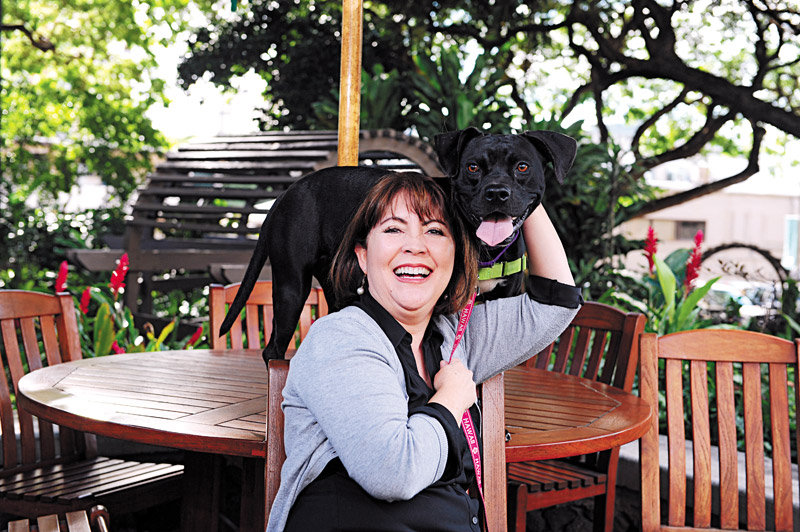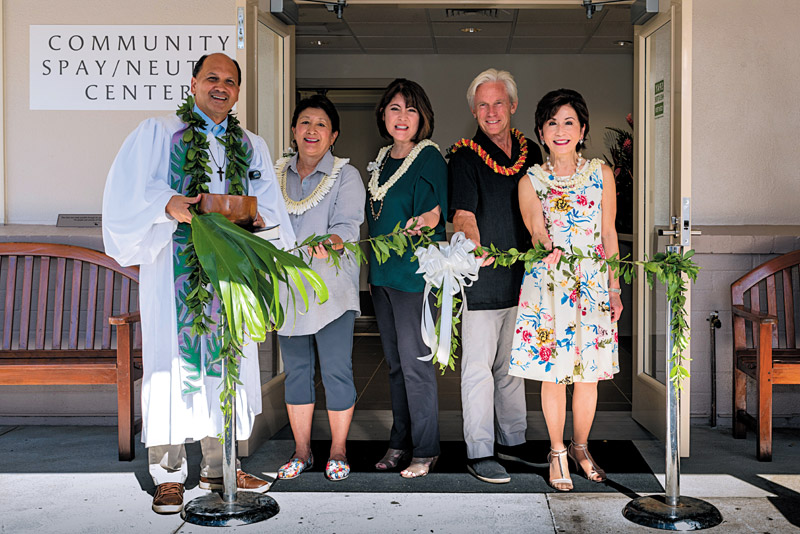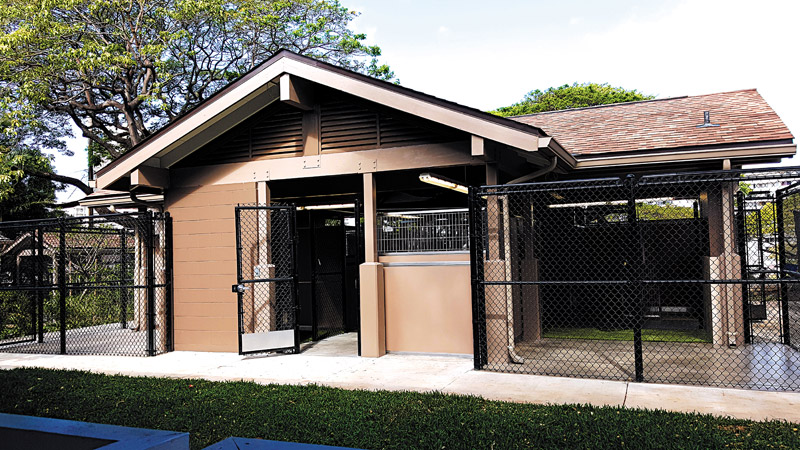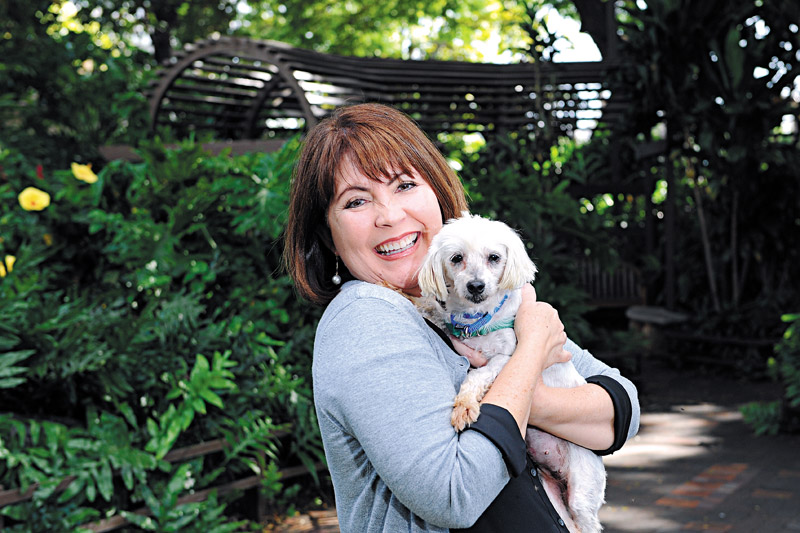Simple Paw-Some

Lisa Fowler poses with adoptable dog Makamae. LAWRENCE TABUDLO PHOTO
Why is Lisa Fowler, president and CEO of Hawaiian Humane Society, smiling so much these days? Because so many good things are happening to her organization, all of which allow it to satisfy one of its core goals: the continual advancement of the human-animal bond.
All it takes is a mere minute or two — maybe even less than that, really — to begin to realize that complete and unadulterated silence probably is not the natural order of things at Hawaiian Humane Society.
In one corner of the Mō‘ili‘ili facility, barks echo in greeting or out of jealousy as one pup, out on an afternoon stroll, saunters past occupied kennels. Howls ring out elsewhere in conversation, while the occasional mew manages to make itself heard, too.
Traversing the grounds, meanwhile, are individuals, couples, friends and families of all ages, walking every which way, their animated chatter adding to the growing symphony.
In the center of it all is Hawaiian Humane Society president and CEO Lisa Fowler, laughing as Makamae (pictured above), available for adoption at the time, nuzzles the top of her head.

Gathered at the opening of Hawaiian Humane Society’s Community Spay/ Neuter Center is (from left) kahu Kordell Kekoa, board member Susan Kosasa, Fowler, board chairman Bob Armstrong and board member Ginny Tiu.
To say she is in her element would be an understatement. To simply accept that she likes her job would be an even bigger one.
“Animals are so connected to people,” says Fowler, who officially became the organization’s top dog in November 2017. “How do we make a difference for the people and the animals in our community? That’s really, for me, the driving force.”
Fowler has long indulged a passion for animals, having worked in animal welfare in some capacity since she was in her early 20s. In fact, she got her start with Hawaiian Humane Society as a special events volunteer.

One of two new dog houses completed as part of an expansion of the nonprofi t’s M°‘ili‘ili campus.
PHOTOS COURTESY HAWAIIAN HUMANE SOCIETY
In more recent years, Fowler served on Hawaiian Humane Society’s board of directors, before moving to the Big Island to take on the role of executive director of Hawai‘i Island Humane Society for about five years. Then, in 2011, with encouragement from Hawaiian Humane Society’s former president and CEO, the late Pamela Burns, Fowler returned home to become the organization’s director of development.
She later became director of operations, a position she held for about a year before taking the helm of the second-oldest charity in the state.
“We got lucky that the person that was best-qualified was very well-known to us,” says board chairman Bob Armstrong, adding that the organization underwent a formal search to fill the position. “She was really ready to step right in. We couldn’t have done better.”
Of course, any transition into a new role, especially one like president and CEO, isn’t without its challenges. But Fowler happened to step in at a time when the organization had been going through some pretty big changes of its own, too.
As director of development, Fowler had successfully led an $18 million capital campaign to fund a new West O‘ahu facility (more on that later) and extensive expansion of its Mō‘ili‘ili campus, the former of which resulted in new dog and cat houses, as well as an admissions building that includes a vet clinic and holding area. Not long after that was completed, Fowler and the organization also dealt with rescuing more than 300 dogs from a puppy mill in Wai‘anae, and, in October, opened its Community Spay/ Neuter Center.

Lisa Fowler smiles with adoptable dog Precious, who’s featured in this week’s Pet Friends Forever on page 46 .
LAWRENCE TABUDLO PHOTO
“It’s just been some very big initiatives all kind of coming into fruition at the same time,” says Fowler with a laugh. “While we’re really proud of that, we also recognize that this is really such a pivotal time in our organization’s history. It’s a really special time for us.”
Hawaiian Humane Society probably more often than not brings to mind dogs, cats and a whole host of other potential pets, like rabbits, guinea pigs, turtles and birds. It’s a fair assessment, considering that, at any given time, the organization is home to a variety of anywhere between 200 and 300 animals.
And perhaps its biggest commitment to the community also lies in one of the greatest misconceptions people have of the institution: that there is a time limit on an animal’s stay.
“People will say … ‘how long does this animal have?'” says Fowler, adding that the second incorrect assumption people make is that the local organization is affiliated with a mainland entity — it’s not.
“The answer is that it’s indefinite,” she continues. “When an animal gets put up for adoption, that animal stays with us until he or she gets a home.”
During its last fiscal year alone (July 1, 2017-June 30, 2018), 7,304 pets were adopted.
But finding animals new homes is not all the nonprofit, with help from numerous volunteers, does for the community. It only scratches the surface.
Among its many services that number roughly 30, the organization works to reunite animals separated from their owners. (Thanks to Hawaiian Humane Society’s efforts, for instance, 2,667 pets found their way home last fiscal year.)
In addition to its regular foster care services, Hawaiian Humane Society also steps in to help individuals fleeing domestic violence or who have been hospitalized, and conducts educational outreach. The latter, Fowler explains, is intended to equip youth with knowledge that extends far beyond the basics of pet care.
“We’re much more focused on … the big picture — the character, the empathy and the compassion that we can instill in our youth to ensure that they’re never going to become abusers,” she adds.
The future of Hawaiian Humane Society looks bright, to hear Fowler outline it.
Now that the Community Spay/Neuter Center is up and running, pet owners have an affordable option to sterilize cats and dogs. More importantly, the nonprofit is hopeful that it will help to make a dent in the free-roaming feline population.
“Our organization felt that this was really the best way that we could contribute and help to be part of the solution for that,” says Armstrong.
Plans also are forging ahead for a second campus in West O‘ahu that will begin construction next year. On 5 acres of land donated by D.R. Horton — and with funds from the capital campaign Fowler was responsible for — Hawaiian Humane Society will soon be a part of the quickly growing community there.
“The population in West O‘ahu has a higher pet ownership rate,” adds Fowler. “West O‘ahu is less condos and more single-family homes, so definitely more animals; a growing, younger population that we’re anxious to be involved with.”
As Fowler goes on to reveal that the new facility will include many of the services its Mō‘ili‘ili counterpart offers, she stops to laugh and reaches for the newest member of her family, a kitten named Lucy (with whom she is photographed on the cover), busily batting at the leaf of a potted anthurium — and it’s this that, in many ways, encapsulates all that Hawaiian Humane Society hopes to accomplish.
“Part of what our mission is, is to promote the human-animal bond,” says Fowler, who also has two dogs, Kiki and Sally. “It’s so gratifying to see people have that incredible bond with their animal, where they want to bring their animal to work or they want to go out in public or they want to walk with their animal, they want to go to a restaurant, they want to go shopping — I love that because animals are just so much a part of our family.
“It’s amazing because no matter what happens in your day, you go home and your animal is there and … it all just melts away,” she adds. “They’re at the door waiting for you. I mean, just amazing, right?”
For more information, visit hawaiianhumane.org.





